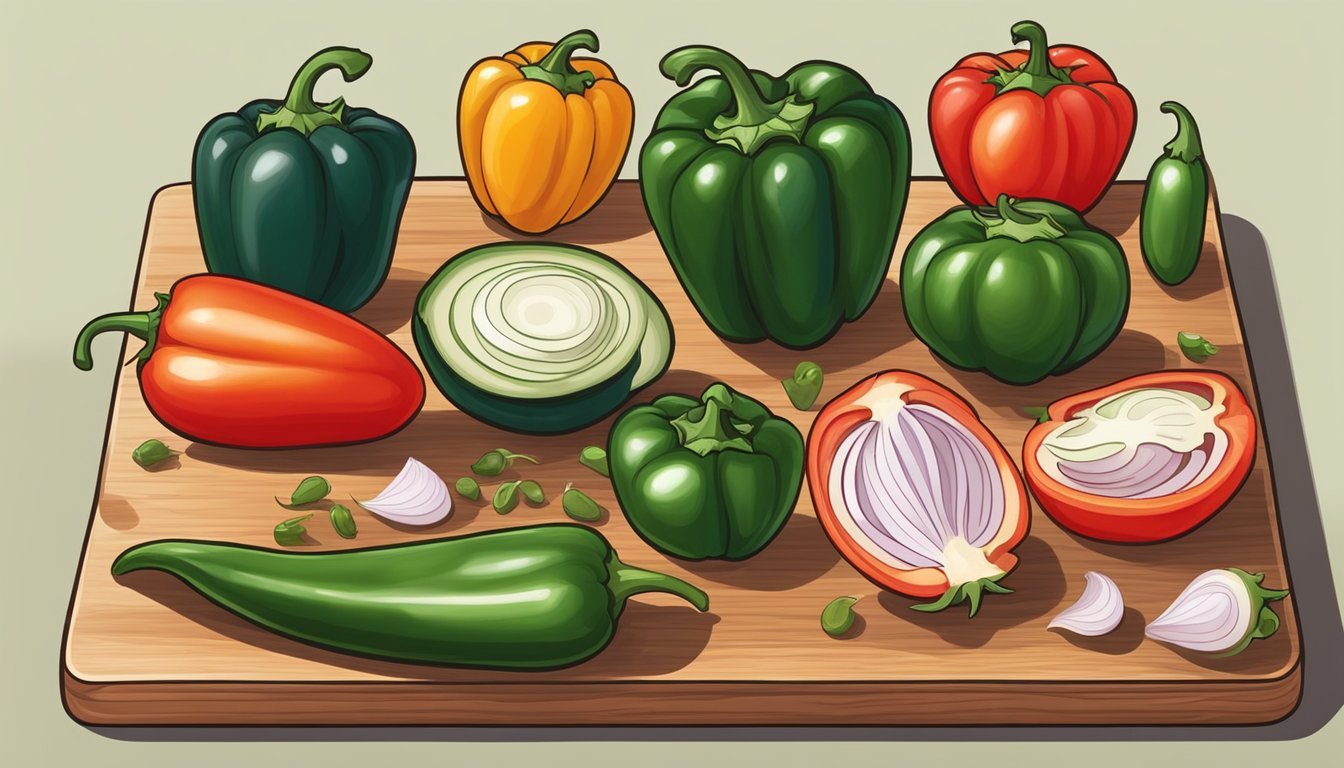Poblano Peppers Substitutes
Top Alternatives for Cooking
Poblano peppers are a popular ingredient known for their mild heat and rich, earthy flavor. But what happens when your recipe calls for poblanos and you have none on hand? Several substitutes can effectively replace Poblano peppers, each bringing its unique qualities to the dish. Whether you're seeking a similar heat level or a comparable size for stuffing, there's a pepper out there that fits your needs.
For those looking to maintain the mild heat of poblanos, Anaheim peppers and Ancho peppers are excellent choices. They offer a similar flavor profile and spice level, making them great alternatives. If a slightly sweeter and larger option is preferred, red bell peppers can be used and are especially useful for stuffed pepper recipes.
For a bit more kick, jalapeno peppers provide a spicier alternative while retaining a pleasant flavor. Meanwhile, banana peppers offer a tangy twist and are perfect for those who want a unique taste without the extra heat. Finding the right substitute for Poblano peppers ensures your dishes remain flavorful and delicious, even when the original ingredient is unavailable.
Understanding Poblano Peppers
Poblano peppers are a significant ingredient in Mexican cuisine, known for their mild heat. They bring distinct flavors to various dishes while offering valuable nutritional benefits.
Origin and Culinary Uses
Poblano peppers originate from Mexico and are a staple in Mexican cuisine. They have a deep green color and are typically larger than many other chili peppers. Because of their size, they are often used in dishes like Chiles Rellenos, where they are stuffed with cheese or meat.
Other popular dishes include Rajas Con Crema, a creamy pepper and corn mix, and mole sauce, where they add depth to the rich, complex flavors. They are also frequently used in stews and sauces due to their versatile nature.
Heat Profile and Nutritional Value
Poblano peppers are known for their mild heat. On the Scoville Heat Units (SHU) scale, they measure between 1,000 and 2,000 SHU, making them suitable for those who prefer less spiciness. Despite their mildness, they offer a distinctive flavor that enhances dishes without overpowering them.
In terms of nutritional value, poblanos are low in calories, with around 30 calories per cup. They're a good source of fiber, Vitamin C, Vitamin A, and potassium, contributing to a healthy diet. They also provide small amounts of protein and iron, making them a nutritious addition to any meal.
Primary Poblano Pepper Substitutes
Several substitutes can replace poblano peppers effectively while maintaining the desired texture, flavor, and heat. Below are some commonly used alternatives, each with distinct characteristics.
Anaheim Pepper
Anaheim peppers are mild with a Scoville Heat Unit (SHU) range of 500-2,500. They are a popular substitute for poblano peppers due to their similar heat level and taste profile. Although slightly more elongated and lighter in color, they make an excellent replacement when mild spiciness is required.
Key Points:
Heat Level: Mild (similar to poblano)
Size & Shape: Longer and thinner than poblanos
Usage: Ideal for roasting, stuffing, and grilling
Usage Tip: Substitute Anaheim peppers in a 1:1 ratio for poblano peppers in recipes like stuffed peppers or salsas.
Bell Pepper
Bell peppers, particularly green and red varieties, are frequently used as substitutes for poblano peppers. While bell peppers are not spicy and have different flavor profiles, their texture and sweetness make them suitable for many recipes requiring poblano peppers.
Key Points:
Heat Level: None (0 SHU)
Color Varieties: Green, red, yellow, orange
Flavor Profile: Green is less sweet, red is sweeter
Usage Tip: Use green bell peppers for a closer match to poblanos in texture and slightly milder flavor. Red bell peppers can provide a sweeter and more colorful alternative.
Cubanelle Pepper
Cubanelle peppers, also known as Italian frying peppers, are another good substitute for poblano peppers. They are mild and have a subtle sweetness, with a SHU range of 100-1,000. Their thin walls make them excellent for quick frying and light stuffings.
Key Points:
Heat Level: Mild (slightly spicier than bell peppers)
Appearance: Long, slender, and light green
Flavor Profile: Mild, with a hint of sweetness
Usage Tip: Ideal for recipes where a delicate flavor is preferred, their mild heat and thin walls make them great for frying or stuffing.
These substitutes provide flexibility in various dishes, offering a range of flavors and heat levels to suit diverse culinary needs.
Secondary Substitutes with Unique Flavors
When looking for a unique twist on traditional poblano pepper substitutes, several options can offer distinct flavors. Whether you are aiming for a spicier kick, a sweet and smoky complexity, or a milder taste, the following alternatives can adapt to your culinary needs.
Spicier Alternatives
For those seeking more heat, Serrano Peppers and Habanero Peppers are excellent choices. Serrano peppers have a sharper, more pronounced heat than poblanos and can elevate dishes needing an added kick. Cayenne Peppers also serve as a potent substitute with their intense spiciness and pungent flavor profile.
Habanero Peppers are much hotter than poblanos and boast a fruity undertone, making them suitable for those who appreciate a complex, fiery taste. Lastly, Tabasco Peppers can offer a strong heat and tang and are ideal for hot sauces and spicy condiments.
Sweet and Smoky Options
If a dish calls for a sweet and smoky note, Chipotle Peppers and Ancho Chili Peppers are viable options. Chipotle Peppers, which are smoked and dried jalapeños, provide a deep, smoky flavor that pairs excellently with barbeque dishes and stews.
Ancho Chili Peppers, dried and ripened poblano peppers, offer a mild heat with a rich and slightly sweet taste. Mulato Chile Peppers provide another layer of sweetness and a hint of smokiness, making them perfect for mole sauces.
Milder Choices
For a subtler flavor, Banana Peppers and Pepperoncini work well in various recipes. Banana Peppers are known for their mild heat and slight sweetness and are great for stuffing or pickling.
Pepperoncini offers a gentle tang with minimal spiciness, suitable for salads and antipasto platters. Lastly, New Mexico Chiles and Hatch Chile Peppers are versatile options with a mild to moderate heat level, often used in Southwestern cuisine for their earthy taste.
Suitable Substitutes in Common Dishes
Selecting the right substitute for Poblano peppers can enhance the flavor of your dishes without compromising their taste or texture.
Salsa and Sauces
In salsas and sauces, green bell peppers can be a good alternative due to their mild, slightly sweet taste. For more heat, jalapeno peppers are suitable, offering a comparable spiciness.
Guajillo peppers can add a smoky flavor, particularly beneficial in complex sauces like mole. Additionally, mulato peppers, which are dried poblanos, impart a rich sweetness with hints of chocolate and licorice, making them ideal for traditional Mexican sauces.
Stir-Fries and Salads
For stir-fries and salads, Cubanelle peppers are excellent due to their mild heat and slightly sweet flavor, closely resembling poblanos. Red bell peppers are another versatile option; their sweetness can enhance the overall flavor profile of salads.
Bell peppers, especially green ones, can work perfectly in stir-fries, maintaining a similar texture to poblanos while adding a fresh taste. Jalapenos add an extra kick if more heat is desired.
Stews and Roasted Dishes
When preparing stews and roasted dishes, dried chilies such as ancho and guajillo peppers are often used for their rich, complex flavors. Mulato peppers can provide the necessary depth and sweetness, complementing slow-cooked recipes.
Bell peppers can also replace poblanos, especially in roasted dishes, where their robustness adds a pleasant crunch. In stews, their texture holds well, ensuring a satisfying bite with each spoonful.
These substitutes help maintain the integrity of traditional dishes while allowing for flexibility in ingredients.
Guidelines for Choosing the Right Substitute
When substituting poblano peppers in a recipe, it is vital to consider factors such as heat level, flavor profile, texture, and size. These aspects ensure the substitute harmonizes well with the dish and does not alter its intended taste or structure significantly.
Considering Heat and Flavor
Poblano peppers are relatively mild, falling between 1,000 to 2,000 Scoville Heat Units (SHU). When choosing a substitute, Anaheim peppers are a suitable option as they share a similar heat level, ranging from 500 to 2,500 SHU. They offer a comparable earthy and slightly sweet flavor.
If a milder substitute is needed, bell peppers can be used, but be aware they have no spiciness, which might alter the dish's heat balance. For those who prefer a similar flavor but with a bit more kick, Cubanelle peppers can be an alternative, though they are generally milder than poblanos, ranging from 100 to 1,000 SHU.
Assessing Texture and Size
The texture and size of the pepper impact the dish's mouthfeel and visual appeal. Poblano peppers are generally large and have a thick, fleshy texture that holds up well when roasted or stuffed.
Anaheim peppers are similar in size but slightly firmer, making them a practical choice for roasting and stuffing. For recipes where the pepper is not the central ingredient but contributes to the overall texture, bell peppers can be a workable option due to their thick walls and substantial size. They are also widely available, making them an accessible substitute.
For dishes requiring a pepper with a thinner wall, Cubanelle peppers provide a good alternative. They have a less robust texture compared to poblanos but work well in recipes such as sautéed dishes or sauces where a softer texture is acceptable.
Nutritional Comparisons of Substitutes
Poblano peppers are low in calories and rich in nutrients. When seeking substitutes, it's crucial to consider the nutritional differences.
Red Bell Peppers
Calories: Approximately 25 per medium pepper
Vitamin C: High, around 169% of the Daily Value (DV)
Vitamin A: Moderate
Fiber: 2.5 grams
Fat: Less than 1 gram
Protein: 1 gram
Banana Peppers
Calories: About 33 per 100 grams
Vitamin C: Moderate
Vitamin A: Minimal
Fiber: 1.2 grams
Fat: Less than 1 gram
Protein: 1 gram
Jalapeño Peppers
Calories: Roughly 4 per 1 medium pepper
Vitamin C: High
Vitamin A: Significant
Fiber: 0.4 grams
Fat: Less than 1 gram
Protein: 0.1 gram
Pasilla Chile Peppers
Calories: Approximately 20 per 100 grams
Vitamin C: Lower than bell peppers
Vitamin A: Moderate
Fiber: 2.5 grams
Fat: Less than 1 gram
Protein: 1 gram
Cayenne Peppers
Calories: About 17 per teaspoon (ground)
Vitamin C: Low
Vitamin A: High
Fiber: Negligible in small serving sizes
Fat: Less than 1 gram
Protein: Less than 1 gram
Comparing these substitutes, red bell peppers stand out for their high Vitamin C content and low calorie count, making them suitable for nutrient-dense dishes. Meanwhile, jalapeños offer a boost of Vitamin A with minimal calories. Pasilla and banana peppers are also decent choices, bringing moderate vitamin and fiber content. Cayenne peppers, while rich in Vitamin A, are typically consumed in smaller quantities due to their heat.








